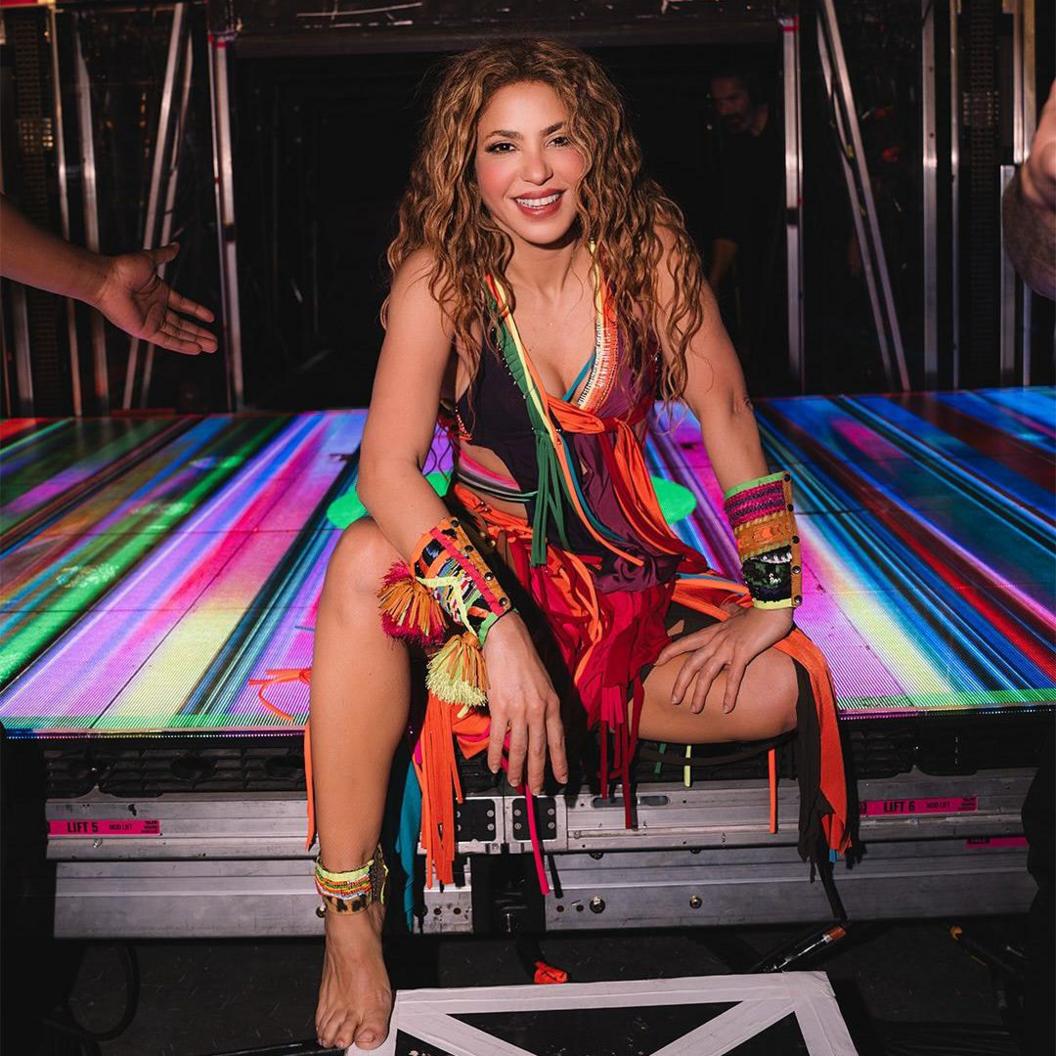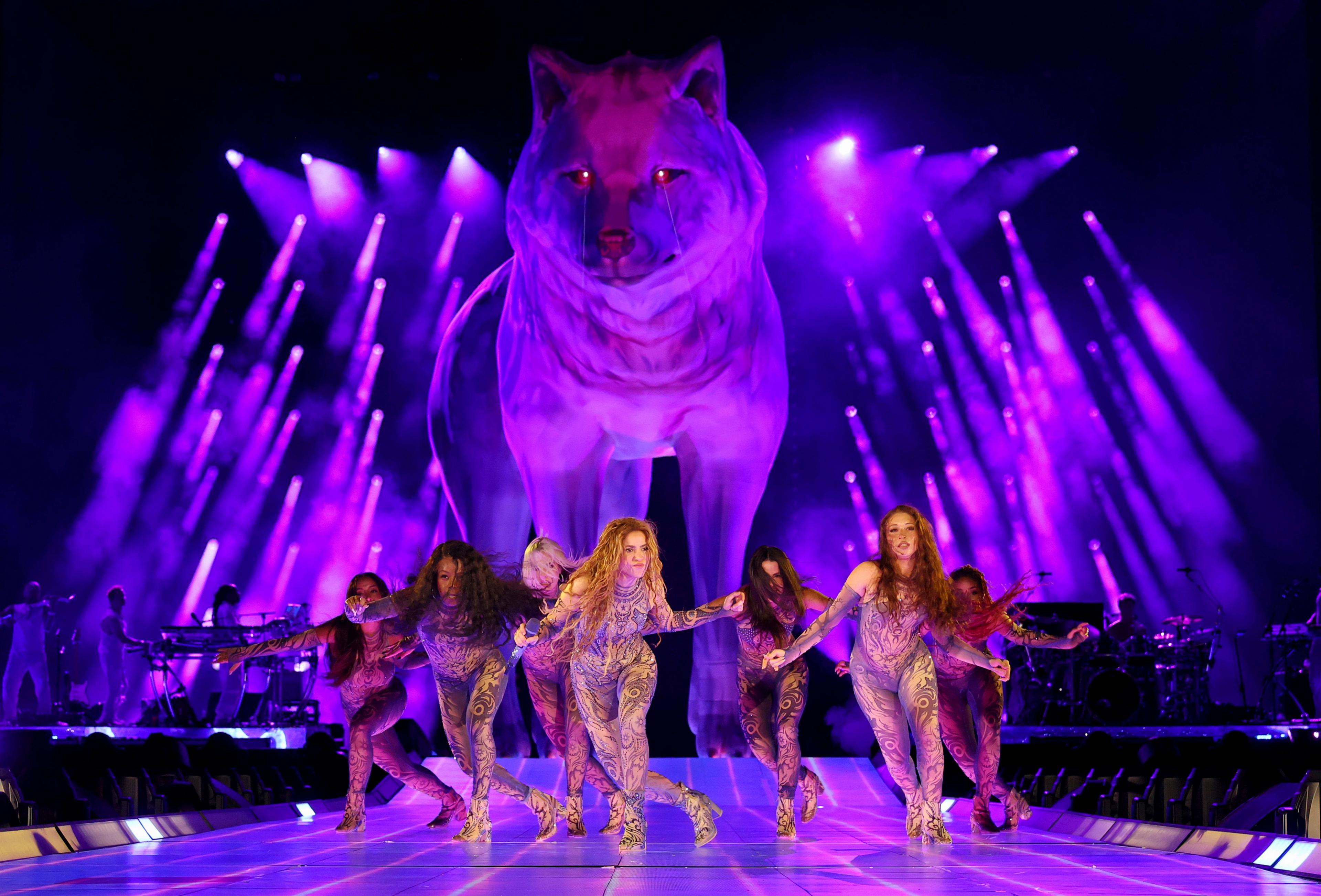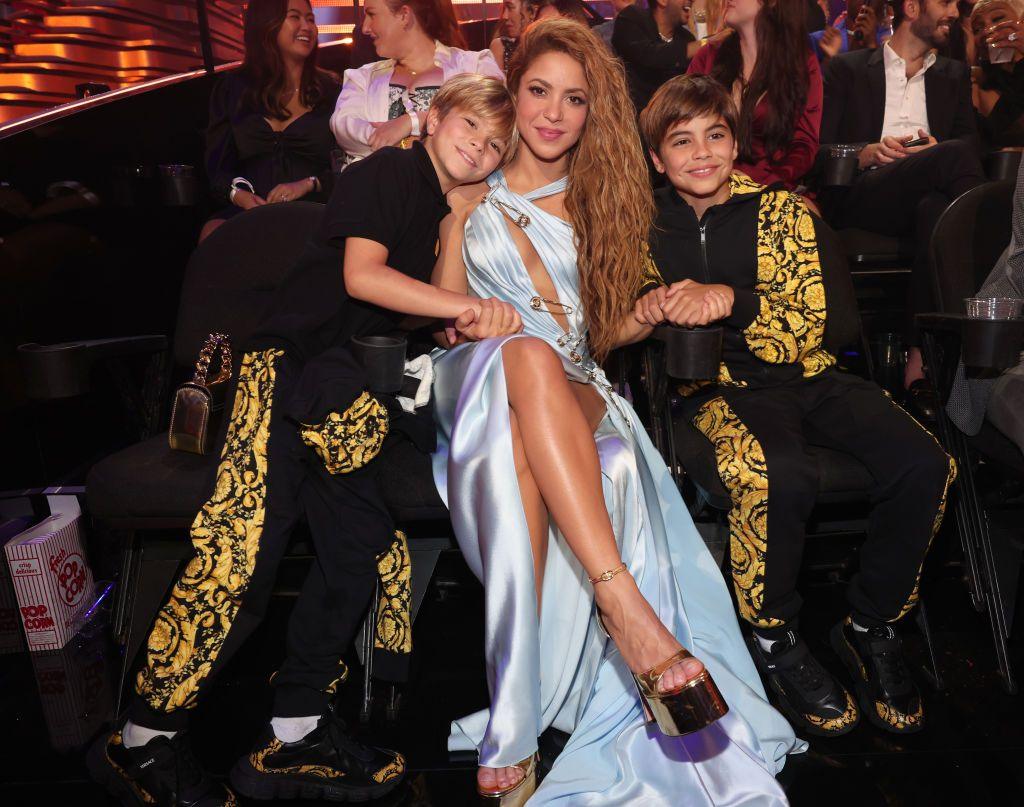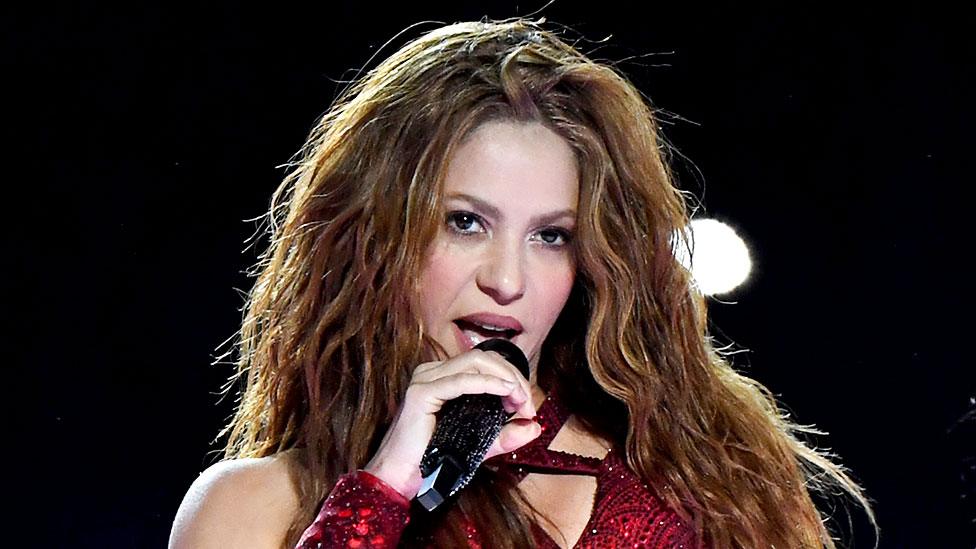'My kids are the reason I'm alive': Backstage with Shakira
- Published

Deep in the bowels of Miami's Hard Rock Stadium, a note is taped to the door of Shakira's production office. "Please come back later... unless you're actually on fire."
The handwritten pink scrawl suggests a level of stress that is entirely understandable for the team putting on the biggest stadium tour of the year.
With 64 sold out shows across North and South America, Shakira has played to more than two million fans.
"I've worked for over a year, polishing every single detail of the show, so this is really an amazing reward," the star tells BBC News.
There are no frayed nerves or screaming matches backstage before the Miami show... and no-one's on fire.
The vibe is calm and professional. Dancers stretch in the corridors, seamstresses sew crystals onto catsuits, and guitar techs check and re-check their tunings.
Hang around long enough and you discover a few surprising tour facts.
"We travel with two washing machines and two tumble dryers, which we plumb in [at] every venue," says head of wardrobe Hannah Kinkade, who has a mere 300 costumes to care for.
Stitched, Scrubbed and Stage-Ready: Meet the woman behind Shakira’s tour costumes
Every outfit has to be refreshed before a new show, she says, because "Shakira dances really hard and the dancers do as well.
"The male dancers scuff their shoes so badly that we have to repaint them every morning."
Birmingham-born stage manager Kevin Rowe shows us around the dark corridors beneath the stage, where the crew have stashed secret reserves of Gatorade and iced coffee to help them survive the sticky Miami heat.
“It either gets very hot or very wet,” he says of working on an outdoor show. “But that’s the trade-off of living in the underworld.”
Backstage With Shakira
Spend a day with Shakira and her team as they prepare for her sell out gig in Miami.
Available to watch now

All the sets are stashed away under the stage, and lifted into place on elevators at different times during the show. Shakira's shoes are already in place on this studded-crystal staircase, waiting for her costume change
At about 2:30pm, the band start their sound check. Shortly after 3pm, Shakira herself arrives with her non-deceitful hips, flanked by a police escort, and joins the team on stage.
Dressed in flared silver jeans and a white vest top, she can't help dancing as she assesses tonight's venue.
"I came here for the Beyoncé concert and that was flawless, so you'd better make me sound like that," she jokes to the crew.
Or is it a joke?
Shakira delivers the quip with a wink, but there's one thing everyone acknowledges backstage: The boss is a perfectionist.
"When she's on, she's on," says chief dancer Darina Littleton. "When she comes in, she's ready, her character's on, she's full out."
"She knows what she wants, and if she can't figure it out she'll get there one way or another," says musical director Tim Mitchell, who's been playing with Shakira since the 1990s (he even wrote the pan pipe riff on Whenever, Wherever).
"She's very particular about every aspect of the show: Sound, visual, lighting, the wristbands, every single thing. It's incredible. I don't know how she does it."

Shakira's two-and-a-half hour show is an intense physical workout
The obsession pays off.
Shakira's concert is two-and-a-half hours of musical drama - a non-stop parade of bilingual hits, 13 costume changes and non-stop movement.
She performs a Lebanese-inspired belly dance during Ojos Asi; a tribal knife routine to introduce Whenever, Wherever; thrashes a Flying-V guitar during Objection (Tango); and has the audience howling and braying through an electrifying version of She Wolf.
The tour is titled Las Mujeres Ya No Lloran (Women No Longer Cry) after Shakira's latest album, which was inspired by some of the most intense heartbreak and personal upheaval she'd ever experienced.
Her 11-year relationship with footballer Gerard Piqué fell apart, at the same time as her father had emergency brain surgery, and Spanish authorities accused her of €14.5m (£12.7m) tax fraud (she settled the case out of court).
"Many of you know that the past years haven't been the easiest for me," she says on stage. "But who doesn't have a fall here and there, right?
"What I've learned is that a fall isn't the end, but the beginning of an even better journey."
More specifically, the turbulence of her mid-40s prompted a creative outburst that put Shakira back in the cultural conversation after seven years of musical silence.
2023's Bzrp Music Sessions Vol 53, a collaboration with Argentine producer Bizarrap, was full of barbs directed at Piqué and his new girlfriend ("you traded a Rolex for a Casio") and won song of the year at the Latin Grammys.
She continued the theme on a string of hit singles like the sarcastic Te Felicito (I Congratulate You) and TQG (Te Quedó Grande - I'm Too Good for You), a duet with fellow Colombian star Karol G, which has racked up 1.3 billion streams on Spotify.
"She's so inspiring to women," says one fan, wearing furry she-wolf ears, shortly before the show. "She's done it all. She is power."
Experience what it's like to walk on stage with Shakira
Shakira's commitment to the show is such that she wants our interview to take place after she comes off stage. So shortly after midnight, she appears from her dressing room, somehow looking fresher than a field of daisies.
"I warn you, I might not make a lot of sense right now," she laughs. "I'm still recovering.
"It was really hot today and humid. So whenever it's like that, or there's altitude, it's very challenging... but totally worth it."
What happens when she's tired or ill?
"To put together a show of this size, and to make it happen every night, it doesn't matter if you're sad or if you had a bad day or if you're sick or you're coughing - you just have to do your best and miraculously make it happen.
"And the adrenalin actually doesn't let me feel the exhaustion, or how demanding it can be. It carries you through."
Learning from Leonard Cohen
Playing in Miami was particularly meaningful, she says, because it's the city she moved to as a teenager, hoping to break into the Western pop market.
By that point, she was already a star in Colombia, but she knew international success meant singing in English. The only problem was, she had never learned it.
"I was only 19 when I moved to the US, like many other Colombian immigrants who come to this country looking for a better future," she says.
"And I remember I was surrounded by Spanish-English dictionaries and synonym dictionaries - because back in the day I didn't really have Google or ChatGPT to [help]. So it was all very precarious.
"And then I got into poetry and started reading a little bit of a Leonard Cohen and Walt Whitman and Bob Dylan, trying to understand how the English language works within songwriting. I think that's how I got good at it."
Lately, she's been reflecting on those experiences, her acceptance in America, and how that contrasts with the Trump administration's attitude to immigrants.
Accepting the Grammy for best Latin pop album earlier this year, she addressed the situation directly.
"I want to dedicate this award to all my immigrant brothers and sisters in this country. You are loved, you are worth it, and I will always fight with you," she said.
How does it feel, I ask, to be an immigrant in the US today?
"It means living in constant fear," she says. "And it's painful to see.
"Now, more than ever, we have to remain united. Now, more than ever, we have to raise our voices and make it very clear that a country can change its immigration policies, but the treatment of all people must always be humane."

Shakira caught up with the BBC an hour after coming off stage

The show ends with Shakira performing under a giant statue of a She-Wolf she's christened Isabel
It's a powerful statement – spoken partially in Spanish as Shakira addresses her Latin American fans directly.
That connection underpins the success of her tour - fans have grown up with Shakira and see themselves reflected in her.
In Miami, the audience spans generations – with mothers and daughters singing in unison to 90s hits like Pies Descalzos, Sueños Blancos and bouncing around to a celebratory Waka Waka (This Time for Africa).
That's why the emotional high point of the show comes during Acróstico – the tender ballad Shakira wrote for her children, promising them she'd stay strong amid the split from Piqué.
As she performs, Sasha (12) and Milan (10) appear on the video screens, duetting with their mum.
"My heart melts every time I see them on that screen and I hear their little voices," says the star.
"They're just everything to me. They're my engine and the reason why I'm alive. So having them every night on stage, it's just such a precious moment."

Shakira's sons Sasha (right) and Milan (left) live with her in Miami
This is the first time the boys have been old enough to see their mum perform in concert, and she confesses they have "mixed emotions" about it.
"When I have a show, they're kind of stressed out because they want everything to come out perfect for me," she says.
"They're always worried, like, 'Mom, how did it go? Did you fall? Are you OK?'
"And I try to show them that there's no perfect show. It's OK to make a mistake."
The question for UK fans is, will the tour come to Europe?
"You have to stay tuned. Wait and see," Shakira teases.
"We can't say dates yet, but we're close to announcing. I really want to share this show with my fans from all over the world."
Related topics
- Published27 December 2023

- Published20 November 2023

- Published13 January 2023

- Published30 September 2021

- Published10 June 2018
